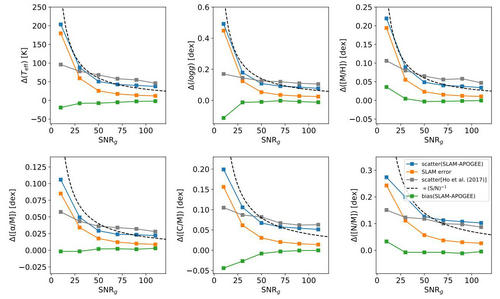Researchers from National Astronomical Observatories, Chinese Academy of Sciences (NAOC), Dr. Bo Zhang, Prof. Chao Liu and Prof. Licai Deng, have developed the Stellar LAbel Machine (SLAM), a new approach based on machine learning to derive precise stellar labels, i.e. stellar atmospheric parameters and elemental abundances, from stellar spectra.
Using SLAM, the researchers successfully derived precise stellar labels including the carbon and nitrogen abundances for over one million red giant stars with the LAMOST DR5 low-resolution spectra. Combined with chemical evolution model, these results will significantly help to understand the formation and evolution history of the Galaxy. This paper has been published in the Astrophysical Journal Supplement.
The long-living FGK-type stars are the best fossil records we can use to constrain the cosmic matter cycle and the Galactic evolution. Accurate and precise abundances of large samples of stars are required. So far, astronomers have collected a huge amount of stellar spectra in several large spectroscopic surveys, for example, SEGUE, RAVE, LAMOST, APOGEE, Gaia-ESO and GALAH. Among them, the LAMOST low-resolution spectroscopic survey has collected over 10 million stellar spectra which are more than the total amount that collected by all the other projects, pushing stellar spectroscopy into a new era and raising new challenges in extracting precise stellar labels for such huge sample of stars from spectra.
There have existed methods to extract stellar labels from spectra. For example, The Cannon, which is a favorable and typical one, but the adopted quadratic polynomial hinders it from modeling stellar spectra across a wide range of stellar labels. Under this context, Zhang and coauthors noticed that the Support Vector Regression (SVR), a well-known non-parameteric regression algorithm, could be the key to this problem, and then constructed the SLAM based on the SVR.
The researchers found that the SLAM has excellent performance in the test with randomly chosen sample within a wide effective temperature range in LAMOST DR5, covering FGK-type stars. Another test based on the LAMOST (DR5)-APOGEE (DR15) common sample shows that SLAM outperforms The Cannon in terms of the precision of stellar labels for spectra with modest and high signal-to-noise ratio. These tests prove that the SLAM has great applicability and potential to extract precise stellar labels for large sample of stars from spectra. As a by-product, the researchers released a catalogue of over one million red giant stars including their effective temperature, surface gravity, metallicity, alpha elemental abundance, and carbon and nitrogen abundances.

Figure. The blue and grey lines represent the relation between the accuracy of each parameter of SLAM and The Cannon and the signal-to-noise ratio, respectively. (Credit: Bo Zhang)
Link to the paper: https://iopscience.iop.org/article/10.3847/1538-4365/ab55ef
Link to the source code: https://github.com/hypergravity/astroslam

Address: 20A Datun Road, Chaoyang District, Beijing, China code: 100012
Tel: 010-64888708 E-mail: naoc@nao.cas.cn

